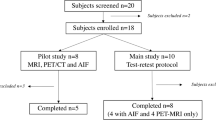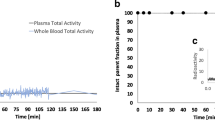Abstract
Purpose
To determine the reproducibility of measurements of brain 5-HT2A receptors with an [18F]altanserin PET bolus/infusion approach. Further, to estimate the sample size needed to detect regional differences between two groups and, finally, to evaluate how partial volume correction affects reproducibility and the required sample size.
Methods
For assessment of the variability, six subjects were investigated with [18F]altanserin PET twice, at an interval of less than 2 weeks. The sample size required to detect a 20% difference was estimated from [18F]altanserin PET studies in 84 healthy subjects. Regions of interest were automatically delineated on co-registered MR and PET images.
Results
In cortical brain regions with a high density of 5-HT2A receptors, the outcome parameter (binding potential, BP1) showed high reproducibility, with a median difference between the two group measurements of 6% (range 5–12%), whereas in regions with a low receptor density, BP1 reproducibility was lower, with a median difference of 17% (range 11–39%). Partial volume correction reduced the variability in the sample considerably. The sample size required to detect a 20% difference in brain regions with high receptor density is approximately 27, whereas for low receptor binding regions the required sample size is substantially higher.
Conclusion
This study demonstrates that [18F]altanserin PET with a bolus/infusion design has very low variability, particularly in larger brain regions with high 5-HT2A receptor density. Moreover, partial volume correction considerably reduces the sample size required to detect regional changes between groups.
Similar content being viewed by others
References
Ito H, Nyberg S, Halldin C, Lundkvist C, Farde L. PET imaging of central 5-HT2A receptors with carbon-11-MDL 100,907. J Nucl Med 1998;39:208–14.
Biver F, Goldman S, Luxen A, Monclus M, Forestini M, Mendlewicz J, et al. Multicompartmental study of fluorine-18 altanserin binding to brain 5HT2 receptors in humans using positron emission tomography. Eur J Nucl Med 1994;21:937–46.
Kristiansen H, Elfving B, Plenge P, Pinborg LH, Gillings N, Knudsen GM.: Binding characteristics of the 5-HT2A receptor antagonists altanserin and MDL 100907. Synapse 2005;58:249–57.
Price JC, Lopresti BJ, Meltzer CC, Smith GS, Mason NS, Huang Y, et al. Analyses of [18F]altanserin bolus injection PET data. II: consideration of radiolabeled metabolites in humans. Synapse 2001;41:11–21.
Pinborg LH, Adams KH, Svarer C, Holm S, Hasselbalch SG, Haugbol S, et al. Quantification of 5-HT2A receptors in the human brain using [18F]altanserin-PET and the bolus/infusion approach. J Cereb Blood Flow Metab 2003;23:985–96.
Smith GS, Price JC, Lopresti BJ, Huang Y, Simpson N, Holt D, et al. Test-retest variability of serotonin 5-HT2A receptor binding measured with positron emission tomography and [18F]altanserin in the human brain. Synapse 1998;30:380–92.
Adams KH, Pinborg LH, Svarer C, Hasselbalch SG, Holm S, Haugbol S, et al. A database of [18F]-altanserin binding to 5-HT2A receptors in normal volunteers: normative data and relationship to physiological and demographic variables. Neuroimage 2004;21:1105–13.
DeGrado TR, Turkington TG, Williams JJ, Stearns CW, Hoffman JM, Coleman RE. Performance characteristics of a whole-body PET scanner. J Nucl Med 1994;35:1398–406.
Lewellen TK, Kohlmeyr SG, Miyaoka RS, Kaplan MS, Stearns CW, Schubert SF. Investigation of the performance of the General Electric ADVANCE positron emission tomograph in 3D mode. IEEE Trans Nucl Sci 1996;43:2199–206.
Woods RP, Cherry SR., Mazziotta JC. Rapid automated algorithm for aligning and reslicing PET images. J Comput Assist Tomogr 1992;16:620–33.
Sadzot B, Lemaire C, Maquet P, Salmon E, Plenevaux A, Degueldre C, et al. Serotonin 5HT2 receptor imaging in the human brain using positron emission tomography and a new radioligand, [18F]altanserin: results in young normal controls. J Cereb Blood Flow Metab 1995;15:787–97.
van Dyck CH, Tan PZ, Baldwin RM, Amici LA, Garg PK, Ng CK, et al. PET quantification of 5-HT2A receptors in the human brain: a constant infusion paradigm with [18F]altanserin. J 2000;41:234–41.
Lopresti B, Holt D, Mason NS, Huang Y, Ruszkiewicz J, Perevuznik J, et al.: Characterization of the radiolabeled metabolites of [18F]altanserin: implications for kinetic modeling. In: Carson RE, Daube-Witherspoon ME, Herscovitch P, editors. Quantitative functional brain imaging with positron emission tomography. San Diego: Academic Press; 1998; p 293–8.
Willendrup P, Pinborg LH, Hasselbalch SG, Adams KH, Stahr K, Knudsen GM, et al. Assessment of the precision in co-registration of structural MR-images and PET-images with localized binding. In: Iida H, Shah NJ, Hayashi T, Watabe H. Quantification in biomedical imaging with PET and MRI. International Congress Series. 2004;1265:275–80.
Svarer C, Madsen K, Hasselbalch SG, Pinborg LH, Haugbol S, Frokjaer VG, et al. MR-based automatic delineation of volumes of interest in human brain PET images using probability maps. Neuroimage 2005;24:969–79.
Mueller-Gaertner HW, Links JM, Prince JL, Bryan RN, McVeigh E, Leal JP, et al. Measurement of radiotracer concentration in brain gray matter using positron emission tomography: MRI-based correction for partial volume effects. J Cereb Blood Flow Metab 1992;12:571–83.
Quarantelli M, Berkouk K, Prinster A, Landeau B, Svarer C, Balkay L, et al. Integrated software for the analysis of brain PET/SPECT studies with partial-volume-effect correction. J Nucl Med 2004;45:192–201.
Kapur S, Jones C, DaSilva J, Wilson A, Houle S. Reliability of a simple non-invasive method for the evaluation of 5-HT2 receptors using [18F]-setoperone PET imaging. Nucl Med Commun 1997;18:395–9.
Acknowledgements
We wish to thank Karin Stahr and the staff at the PET centre for their technical assistance, and The John and Birthe Meyer Foundation for the donation of the cyclotron and the PET scanner. This work was generously supported by the Danish Health Research Council, The Ludvig and Sara Elsass Foundation, The Hørslev Foundation, Director Jacob Madsen and Wife Olga Madsen’s Foundation, The Augustinus Foundation, The Beckett Foundation, The Foundation for Neurological Research, The A.P. Møller and Chastine McKinney Møller Foundation and The Lundbeck Foundation.
This investigation complies with the current laws in Denmark and was approved by the ethics committee in Copenhagen.
Author information
Authors and Affiliations
Corresponding author
Rights and permissions
About this article
Cite this article
Haugbøl, S., Pinborg, L.H., Arfan, H.M. et al. Reproducibility of 5-HT2A receptor measurements and sample size estimations with [18F]altanserin PET using a bolus/infusion approach. Eur J Nucl Med Mol Imaging 34, 910–915 (2007). https://doi.org/10.1007/s00259-006-0296-y
Received:
Accepted:
Published:
Issue Date:
DOI: https://doi.org/10.1007/s00259-006-0296-y




